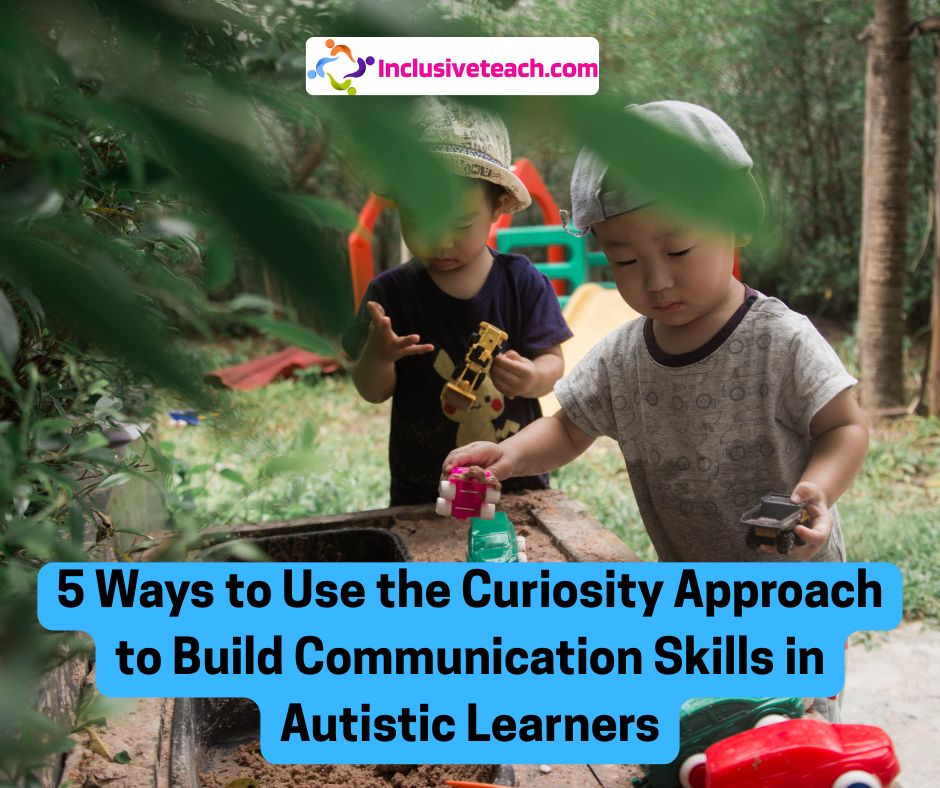
5 Ways to Use the Curiosity Approach to Build Communication Skills
The Curiosity Approach, with its child-led, play-based framework, offers unique opportunities to enhance communication skills. Below are five ways curiosity-led activities, such as storytelling with props and collaborative play, support both verbal and non-verbal communication development in autistic learners, grounded in research and innovative design.
1. Encouraging Storytelling with Sensory Props
Concept: Using props like textured puppets or scented objects in child-led storytelling sessions sparks curiosity and invites communication.
Impact: Storytelling promotes expressive language and narrative skills, with research showing sensory props enhance engagement in autistic learners (Quill, 1997). Non-verbal students can use props to convey ideas, supporting alternative communication.
Innovation: Integrate a “prop board” with visual symbols, allowing students to select items and build sentences, inspired by augmentative communication strategies (Beukelman & Mirenda, 2013).
2. Facilitating Collaborative Play with Open-Ended Materials
Concept: Collaborative play with loose parts (e.g., blocks, fabric) encourages peer interaction and communication through shared exploration.
Impact: Joint play fosters turn-taking and verbal exchanges, while non-verbal cues (e.g., pointing) support social communication, as noted in autism studies (Ganz, 2007). Child-led dynamics ensure comfort and participation.
Innovation: Add a “communication cue box” with picture cards or sound makers to prompt interaction, enhancing both verbal and non-verbal skills.

3. Promoting Inquiry-Based Conversations with Curiosity Boxes
Concept: Curiosity boxes filled with intriguing items (e.g., feathers, small mirrors) prompt students to ask questions or comment, driving communication.
Impact: Inquiry-based activities boost verbal language development, while non-verbal learners can respond with gestures or eye contact, aligning with research on curiosity-driven learning (Whitebread et al., 2017).
Innovation: Include a digital recorder for students to capture their thoughts, offering a novel way to practice communication at their pace.
4. Supporting Role-Play with Sensory Scenarios
Concept: Child-led role-play using sensory-rich scenarios (e.g., a pretend market with textured goods) encourages imaginative dialogue and interaction.
Impact: Role-play enhances verbal communication and social scripts, while non-verbal students can use props to act out roles, supported by evidence on play-based therapy (Kasari et al., 2012).
Innovation: Use a “role-play guide” with tactile prompts (e.g., a shopping list in braille or symbols) to scaffold communication for diverse learners.

5. Enabling Group Storytelling with Collaborative Murals
Concept: Creating murals with sensory materials (e.g., paint, textured rollers) as a group activity sparks shared narratives and communication.
Impact: Collaborative art promotes verbal collaboration and non-verbal cues like pointing or nodding, with studies showing art enhances social communication in autism (Martin, 2009). Child-led input ensures engagement.
Innovation: Incorporate a “story mat” where students place objects to build a group story, blending tactile and communicative elements.

Conclusion
The Curiosity Approach, through curiosity-led activities like storytelling with props and collaborative play, provides a dynamic pathway to build communication skills in autistic learners. By integrating evidence-based practices with innovative tools, educators can support both verbal and non-verbal development, creating inclusive classrooms that nurture expression and connection. Explore further resources like the Hanen Centre or autism communication research for additional insights.
References (for context, not exhaustive):
- Quill, K. A. (1997). Instructional Considerations for Young Children with Autism.
- Beukelman, D. R., & Mirenda, P. (2013). Augmentative and Alternative Communication.
- Ganz, J. B. (2007). Classroom-Based Strategies for Children with Autism.
- Whitebread, D., et al. (2017). The Importance of Play in Early Childhood.
- Kasari, C., et al. (2012). Play and Joint Attention in Autism. Journal of Child Psychology and Psychiatry.
- Martin, N. (2009). Art as an Early Intervention Tool for Children with Autism.

Related
Discover more from Special Education and Inclusive Learning
Subscribe to get the latest posts sent to your email.
Source link



